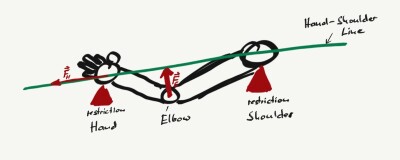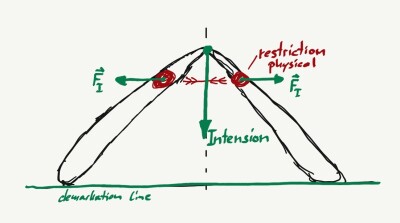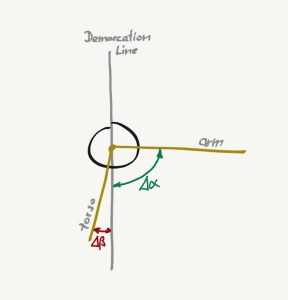Main Exercise
We did a very basic move from Six Sealings four Closings: The out with hand Part:
Preset: Shoulder and Hand lock (better: being locked by partner or other outside restraints)
Action: Elbow moves into the Line of Shoulder — Hand (lead by the other hand pushing the elbow)
Shifu instructed us to use the other hand, to actually push the elbow towards this line.
Result: Clear move of Hand going out.
Training Method: Get somebody to fix Hand and Shoulder. Find a way to adjust the body, so that you can do the required move, i.e. extension of Shoulder — Hand Line by the mentioned action. Important: Kua must support the move. The hole body needs to adapt.
This extension is also called „a stretch“
If you practice alone, you MUST imagine there is a restriction of hand and shoulder. Usually what happens: We imagine the restriction, but as soon as we start the action we lose the „image“ of the restriction.
Background info
Intention
Shifu: Lot’s of talk about intention, but what does it mean?
Shifus explanation in my words:
Intention is what I want to do! Example with Doug holding Shifus wrists while his small arms (forearms) are being hold in a triangle shape. The intention Is „to concentrate and be aware of pushing down the fingers“. This makes the wrists go out.
An outside observer would only see the wrist [and elbows] going out. Trying to copy the move would result in a different move.
You cannot tell the difference [from outside] where the intention is in the move.
Shifu: An action like this we consider to „be open“
Hard vs. Soft
Shifu was talking about two Systems in the body: Hard and Soft.
Hard has Stick-like characteristics. Soft has Rope-like characteristics.
Soft and Hard are everywhere all the time.
You give the structure (e.g. arm) tension: it becomes a rope. You give it loseness: it becomes a stick.
Lead
There is an article by Kelvin Ho about it.
There where two examples
- Short peace of rubber cord with a mark in the middle (could be just some piece of rope)
- A rectangular [wooden] board
For both examples the same applies:
You can hold the rubber cord on either end. The result looks exactly the same.
You can hold the board on either corner. The result looks exactly the same.
But if you make markers on the items you will see, that the outcome isn’t the same. E.g. if you would point each quadrant on the board on both sides in individual colors, they would be arranged differently.
So depending on the lead, the angels and other properties towards the outside environment are completely different.
So, depending on the lead, the outcome is completely different.

The lead on the board is at A or at C. Shape lookes the same, but if you have markers you see the hole situation is different
Intentions vs. Lead
Shifu: Intention is from me. Lead is the physical move.
There is as saying: Best intension is without intention. Meaning: The physical embodiment of the correct movement is in the body and doesn’t need to be intentionally thought about. It just happens.
Shifu: Somebody could copy the move correctly without having the intention [of pushing the elbow towards the line]. This would be intention without intention.
My understanding: This person would not know what makes the movement correct, but it still would be correct.
Conclusion (my words): Having the correct lead is more important than having a good intention. Since lead is the physical manifestation of the intention. But when we train, we (most likely) won’t be ably to skip the intention part, because it’s necessary to establish the right leads.
What does it mean: You moved your shoulder!
Every joint has at least two parts. When you move only the outside part (arm), that’s ok, i.e. shoulder didn’t move. But when you move the other part as well, the move of the first part (arm) penetrates the other part (torso). In that case we say, that the shoulder moved.
In the picture: A change of alpha is ok as long as it doesn’t affect beta.
Wege Power
Shifu introduced a new term: Wedges Power.
A door wedge is an example of the concept „move the middle“.
The lower end doesn’t touch the door. The upper end doesn’t touch the door. They are completely passiv. Only the middle of the Wedge touches the door. And it’s the push of the door, makes the wedge block the door. [the power comes out of the structure of the wedge].
Sidenotes
Some styles use the rear arm at the elbow. This has a function and is not meant to just look nice. It supports the elbow to move towards the hand — shoulder line.
Power is Yang. It goes up.
Going down is Yin.
When you go down and use Power, it doesn’t leak, but can go through.
Where you place your elbow [in the beginning of the move] is irrelevant. Different styles have a different way to do it. But what matters is where towards is the elbow going to!
In the Hand — Elbow — Shoulder triangle the Elbow has to go towards the Hand — Shoulder line.
The Plane the triangle is drawing in space can move, but the aim of the Elbow must still be towards this line.






{ 5 comments… read them below or add one }
Great notes Pawel. I missed the class today but feel as if you presented the heart of it.
Very clear notes, Pawel.
The pictures are very helpful. One minor thing: For the board example, the board on the right should be CBAD if you label the corners in clockwise order. It gets flipped over when you change the lead to C.
Thanks Jody, Vincent and Edward for your feedback.
@Edward: Board doesn’t need to be flippt. If Lead is at A and you then hold D and let A go. The configuration looks exactly the same. That’s why I chose A and D as examples. If you pick B or C as the “next lead”, then in order to get the same shape, you’d need to flip the board.
I tried it with a piece of Paper several time, because I found it very confusing to do it in my mind 🙂
Let’s say that this board is initiallty laid flat on a table, we are lifting straight up one corner at a time, and letting the rest of the board hang down. If you are doing this in front of a stationary camera, the camera will see different sides of the board between lifting A and C.